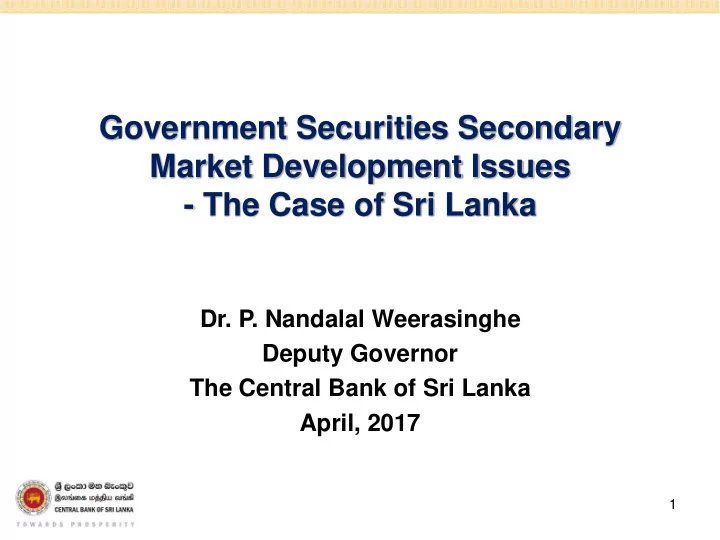

Government Securities Secondary Market Development Issues - The Case of Sri Lanka Dr. P. Nandalal Weerasinghe Deputy Governor The Central Bank of Sri Lanka April, 2017 1
Overview • Development of Government Securities Market in Sri Lanka • Current Status of Government Securities Market • Issues and Challenges in Developing Secondary Market 2
Development of Government Securities Market in Sri Lanka • Sri Lanka regained its independence in 1948 and the Central Bank was established in 1950. Since then, public debt management has been under the Central Bank as an agency function. • In 1997, Sri Lanka government introduced Treasury bonds which is a tradable medium to long term debt instrument. • In 2001, the first dollar denominated debt instrument, Sri Lankan Development Bonds(SLDBs) was introduced to tap excess forex resources in the local market. • Currently, Treasury bond is the main instrument used for mobilization of funds for government budget. In addition, Treasury bills and SLDBs are also issued under the annual borrowing programme. 3
Development of Government Securities Market in Sri Lanka / Contd.. • Key policy measures introduced to develop the secondary market operations include followings; – In 1981, introduction of secondary market operation for Treasury bills – In 1986, the commencement of weekly issues of Treasury bills – Introduction of Primary Dealer System in 1992. – Electronic bidding system from 1998. – Introduction of marketable debt instruments such as Treasury-bonds from 1997. – Dedicated primary dealer system from 2000. – Introduction of Scripless Securities Settlement System (SSSS) in 2004. – Introduction of RTGS system in 2004. contd …/ 4
Development of Government Securities Market in Sri Lanka / Contd.. • Key policy measures introduced to develop the secondary market operations include followings ; – Opening of Treasury Bills and Bond Markets for foreign investors was limited since 2006 (5% in 2006 and then 10% in 2007 and 12.5% in 2012 and reduced to10% in 2015). – Extended PD system by allowing banks as PDs. – Introduction of Two-way quotes system for all PDs for all outstanding marketable instruments. – Development of market based yield curve. – Introduction of Bloomberg platform to record all trading above LKR 50 mn in order to improve transparency and price discovering in secondary transactions. – Secondary market operations are made free from taxes to encourage tradings in the secondary market. 5
Current Status of Government Securities Market in Sri Lanka • As at end 2016, SL GDP: USD 82bn • Total Government Debt: 80% of GDP – Domestic Debt: 45.1% of GDP – Foreign Debt: 34.2% of GDP 6
Current Status of Government Securities Market in Sri Lanka Domestic Debt by Instruments • High concentration towards market-based instruments. • More rely on T Bond: Medium to Long-term instruments to lower the rollover risk. 7
Current Status of Government Securities Market in Sri Lanka Domestic Debt by Ownership Provident funds, saving institutions, commercial banks, insurance companies 8 and private corporates are major investors
Current Status of Government Securities Market in Sri Lanka Marketable Debt Instruments by Ownership-2016 • Long-term funds such as super annuation funds, insurance companies banks and saving institutions are key investors in Government Securities Market. 9
Issues and Challenges in Developing Secondary market… – Supply related issues – Demand related issues – Infrastructure issues – Other issues 10
Issues and Challenges in Developing Secondary market / Contd. • Supply Related Issues – Lack of annual borrowing calendar. – Lack of regular issuance plan for Treasury Bonds. – Add-hoc changes in issuing plan and system of conducting primary auctions – High fragmentation of tradable instruments. – Bunching of maturities leading to high Refinancing Risk. – More “Off -the- Run” bond series. – Lack of buy-back, switching and reverse auctions process in the secondary market to address bunching issues. Contd …/ 11
Issues and Challenges in Developing Secondary market / Contd. • Demand Related Issues – Limited investors in the longer end of the yield curve. – Lack of well liquid market due to limited trading. – More “buy and hold” type investors. contd …/ 12
Issues and Challenges in Developing Secondary market / Contd. • Infrastructure Issues – Lack of mandatory requirement for Primary Dealers to be success in the primary action. – Non availability of Central Counter Party System. – Non availability of comprehensive low cost trading platform. – Non availability of developed derivatives market. 13
Other Issues • Week monetary policy transmission to medium-long term yield curves. 14.00 13.00 12.00 11.00 10.00 9.00 8.00 7.00 6.00 3 6 12 2 Year 3 Year 4 Year 5 Year 6 Year 8 Year 10 15 Month Month Month Year Year 30/12/2015 30/12/2016 21/04/2017 • Since early 2015, policy rates were increased by 125 basis points whereas one-year T-Bill rates increased by 380 basis points. • T-Bond yield curve also shifted upwards significantly due to 100% market based primary auction system compared to the previous hybrid system. 14
Recommend
More recommend